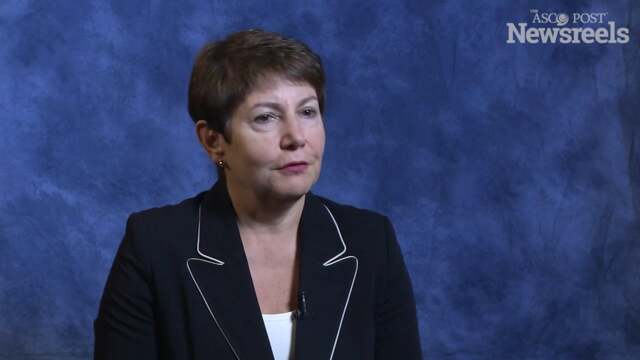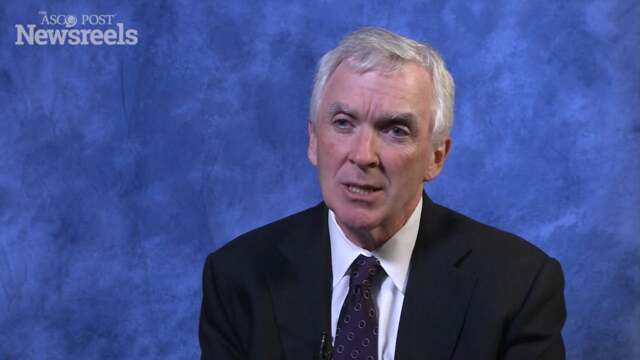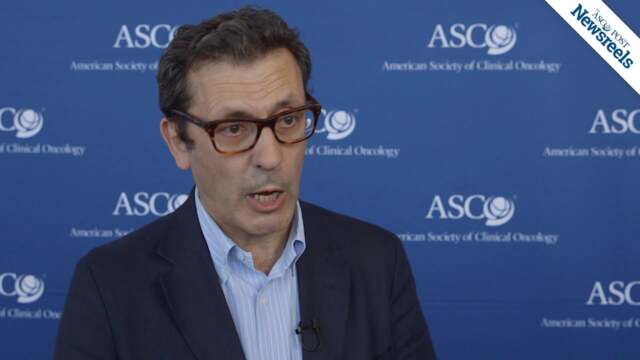ASTRO 2016: Hypofractionated Radiation Therapy May Halve Treatment Time for Lung Cancer Patients With Poor Performance Status
For patients with stage II and III non–small cell lung cancer (NSCLC) unable to receive standard treatments of surgery or chemoradiation, hypofractionated radiation therapy results in similar overall survival and progression-free survival rates, limited severe side effects, and shorter...
Maria Werner-Wasik, MD, on Issues in Lung Toxicity
Maria Werner-Wasik, MD, of Thomas Jefferson University Hospital, summarizes a session she moderated on lung toxicity, including the impact of cardiac radiation, the risk of radiation to thoracic vertebral bodies, radiation pneumonitis, and upfront SBRT. (Scientific Session 39)
ASTRO 2016: Advances in Radiation Therapy Have Improved Survival Rates for Patients With Early-Stage Lung Cancer
A new analysis of records in the Veterans Affairs Central Cancer Registry demonstrates a clear positive impact of the increased use of stereotactic body radiation therapy (SBRT) to treat patients with stage I non–small cell lung cancer (NSCLC) in recent years, according to research presented...
ASTRO 2016: Widespread Adoption of SBRT Has Improved Survival Rates for Elderly Patients With Early-Stage Lung Cancer
Survival rates for elderly patients who received stereotactic body radiation therapy (SBRT) for early stage non–small cell lung cancer (NSCLC) rose from roughly 40% to 60% over the past decade, concurrent with the increasing adoption of SBRT, according to research presented by Dalwadi et al...
Thomas J. Lynch, Jr, MD, on Personalized Care and Radiation Oncology in Lung Cancer
Thomas J. Lynch, Jr, MD, of Massachusetts General Hospital, summarizes his keynote lecture on whether we are any closer to curing lung cancer with targeted treatments. (Keynote Address 2)
Combining AM0010 and Pembrolizumab Produced Antitumor Activity in Patients With Advanced Solid Tumors
A multibasket phase Ib study evaluating the clinical activity, tolerability, and antitumor activity of the cytokine-based immunotherapy AM0010 alone or in combination with the immune checkpoint inhibitor pembrolizumab (Keytruda) has found that in monotherapy, objective responses to AM0010 were ...
FDA Grants Priority Review to Pembrolizumab Supplemental Biologics License Application for First-Line Treatment of Advanced NSCLC
The U.S. Food and Drug Administration (FDA) has accepted for Priority Review the supplemental Biologics License Application (sBLA) for pembrolizumab (Keytruda), an anti–PD-1 (programmed cell death protein 1) therapy, for the first-line treatment of patients with advanced non–small cell lung cancer...
Lung Cancer Specialist Shares Clinical Pearls for Managing Stage IIIA Non–Small Cell Lung Cancer
Clinicians face a number of questions in evaluating and treating patients with stage IIIA non–small cell lung cancer (NSCLC). One expert in the field, Rafael Santana-Davila, MD, reviewed key issues in managing this disease in the Journal of Oncology Practice (JOP). The ASCO Post asked Dr....
Immune Checkpoint Inhibitors March to First-Line Treatment in Advanced NSCLC
For the majority of patients who are diagnosed with advanced-stage non–small cell lung cancer (NSCLC), platinum-based doublets have been the standard of care for over 30 years. Recently, the immune checkpoint inhibitors nivolumab (Opdivo) and pembrolizumab (Keytruda) demonstrated superior survival ...
First-Line Nivolumab Alone and Combined With Platinum-Based Chemotherapy in Advanced NSCLC
The phase I CheckMate 012 study examined the effects of nivolumab (Opdivo) monotherapy and nivolumab combined with platinum-based doublets as first-line treatments in patients with advanced non–small cell lung cancer (NSCLC). Encouraging efficacy and safety findings were reported in the Journal...
Combined FISH and IHC Identifies Patients With NSCLC With Rare ALK Fusions That Respond to Crizotinib
The combined use of fluorescence in situ hybridization (FISH) and immunohistochemistry (IHC) identified non–small cell lung cancer (NSCLC) patients with rare or novel anaplastic lymphoma kinase (ALK) gene rearrangements, not otherwise identified by FISH alone, that showed response to...
FDA Modifies Dosage Regimen for Nivolumab
On September 13, 2016, the U.S. Food and Drug Administration (FDA) modified the dosage regimen for nivolumab (Opdivo) for the currently approved indications for renal cell carcinoma, metastatic melanoma, and non–small cell lung cancer (NSCLC). The currently approved recommended dosage...
Little Benefit Reported With WBRT in NSCLC Patients With Brain Metastases Unsuitable for Resection or Stereotactic Radiotherapy
In a UK-based phase III noninferiority trial (QUARTZ) reported in The Lancet, Mulvenna et al found that use of whole-brain radiotherapy in addition to optimal supportive care including dexamethasone was associated with little additional benefit in non–small cell lung cancer (NSCLC) patients...
FDA Grants Priority Review to Pembrolizumab for First-Line Treatment of Advanced NSCLC
The U.S. Food and Drug Administration (FDA) has accepted for Priority Review the supplemental Biologics License Application (sBLA) for pembrolizumab (Keytruda), an anti–PD-1 (programmed cell death protein 1) therapy, for the first-line treatment of patients with advanced non–small...
Phase III Study Launches in Patients With Small Cell Lung Cancer
On August 2, 2016, PharmaMar announced the start of a pivotal phase III ATLANTIS study evaluating the efficacy and safety of lurbinectedin (PM1183), a novel synthetic tetrahydroisoquinoline that targets active transcription. The study is evaluating lurbinectedin combined with doxorubicin vs...
Incidence of PD-1 Inhibitor–Related Pneumonitis in Advanced NSCLC, Renal Cell Carcinoma, and Melanoma
In a systematic review and meta-analysis reported in JAMA Oncology, Nishino et al identified the rates of PD-1 (programmed cell death protein 1) inhibitor–related pneumonitis in patients with advanced non–small cell lung cancer (NSCLC), renal cell carcinoma, and melanoma. Rates were...
Does Lymph Node Metastasis Have a Negative Prognostic Impact in Patients With NSCLC and M1a Disease?
Analysis of a large non–small cell lung cancer (NSCLC) patient cohort with stage IV M1a disease identified lymph node staging as having clinical significance and an impact on prognosis. Findings from the study were published by Dai et al in the Journal of Thoracic Oncology. Lung cancer is...
Pembrolizumab for Untreated/Progressive Brain Metastases in Melanoma or NSCLC
Sarah B. Goldberg, MD, of Yale University School of Medicine, and colleagues found that pembrolizumab (Keytruda) was active in untreated or progressive brain metastases in melanoma and non–small cell lung cancer (NSCLC), according to a single-center phase II trial reported in The Lancet Oncology....
Plasma vs Tissue Genotyping and Outcomes With Osimertinib in Advanced Non–Small Cell Lung Cancer
Patients with advanced non–small cell lung cancer (NSCLC) positive for the epidermal growth factor receptor (EGFR) tyrosine kinase inhibitor T790M resistance mutation on a plasma assay had similar outcomes with the EGFR tyrosine kinase inhibitor osimertinib (Tagrisso) as did those who were positive ...
Ceritinib Shows Overall and Intracranial Activity in Advanced NSCLC Previously Treated With Crizotinib and Chemotherapy
Lucio Crinò, MD, of the University Medical School of Perugia, Italy, and colleagues found that ceritinib (Zykadia) was active overall and in central nervous system (CNS) metastases in patients with ALK-rearranged advanced non–small cell lung cancer (NSCLC) previously treated with crizotinib...
Nivolumab in Recurrent Small Cell Lung Cancer
In the phase I/II CheckMate 032 study, nivolumab (Opdivo) alone and with ipilimumab (Yervoy) demonstrated activity in patients with small cell lung cancer (SCLC) progressing after at least one previous platinum regimen, as reported in The Lancet Oncology by Antonia et al. Study Details In the SCLC...
My Oncologists Make Me Feel Safe Even While Living With Terminal Cancer
Looking back, I’m haunted by what might have been if my advanced non–small cell lung cancer (NSCLC) had been caught in its earliest stage, when perhaps a cure was possible. I certainly presented my physicians with enough clues—shortness of breath, coughing, and some body weakness—to have warranted...
Study Finds Computers Surpass Pathologists in Predicting Lung Cancer Type, Severity
Computers can be trained to be more accurate than pathologists in assessing slides of lung cancer tissues, according to a new study by researchers at the Stanford University School of Medicine. The researchers found that a machine-learning approach to identifying critical disease-related features...
Leptomeningeal Metastases More Common in NSCLC With EGFR Mutations, May Be Responsive to Tyrosine Kinase Inhibitors
Leptomeningeal metastases, a serious complication in lung cancer patients, were found to be more prevalent in patients with non–small cell lung cancer (NSCLC) with epidermal growth factor receptor (EGFR) mutations. In a recent study of leptomeningeal metastases published by Li et al in...
Nivolumab Did Not Meet Primary Endpoint of Progression-Free Survival in NSCLC in CheckMate-026 Trial
Bristol-Myers Squibb Company announced last week that CheckMate-026, a phase III trial investigating the use of nivolumab (Opdivo) as monotherapy, did not meet its primary endpoint of progression-free survival in patients with previously untreated advanced non–small cell lung cancer (NSCLC)...
Dabrafenib Plus Trametinib in BRAF V600E–Mutant Metastatic NSCLC
In a phase II trial reported in The Lancet Oncology, Planchard et al found that combined MAPK pathway inhibition with the BRAF inhibitor dabrafenib (Tafinlar) and the MEK inhibitor trametinib (Mekinist) resulted in a high response rate in patients with BRAF V600E–mutant non–small cell lung cancer...
Low-Dose CT Screening: New Solid Nodules and Lung Cancer Probability
As reported by Walter et al in The Lancet Oncology, incidence screening with low-dose computed tomography (CT) in high-risk individuals detected new solid nodules in approximately 5% to 7% at second and third screenings in the ongoing Dutch-Belgian NELSON trial. Larger nodule size was associated...
David LeDuc Named Executive Director of Addario Lung Cancer Foundation
The Bonnie J. Addario Lung Cancer Foundation (ALCF) has announced that it has appointed David LeDuc as its new Executive Director. Mr. LeDuc most recently served as the Senior Director of Strategic Alliances for the Addario Lung Cancer Medical Institute (ALCMI), a partner foundation to ALCF, where ...
Phase III Trial Finds No Survival Benefit of Adding Ipilimumab to Etoposide/Platinum in Extensive-Stage SCLC
The addition of the anti–CTLA-4 (cytotoxic T-lymphocyte–associated protein 4) checkpoint inhibitor ipilimumab (Yervoy) to etoposide/platinum did not improve overall survival in the first-line treatment of patients with extensive-stage small cell lung cancer (SCLC), according to a phase...
AAPM 2016: Somatic Mutations and PET-Based Radiomic Features in Non–Small Cell Lung Cancer
A cutting-edge method of extracting big data from positron-emission tomography (PET) images can provide additional information to quantify lung tumors caused by a genetic mutation. This information could help guide the most effective treatment, suggest findings of a study of nearly 350 patients...
Ceritinib Shows Overall and Intracranial Activity in Advanced NSCLC Previously Treated With Crizotinib and Chemotherapy
Crinò et al found that ceritinib (Zykadia) was active overall and in central nervous system (CNS) metastases in patients with ALK-rearranged advanced non–small cell lung cancer (NSCLC) previously treated with crizotinib (Xalkori) and chemotherapy, according to the ASCEND-2 phase II...
Lung Cancer Screening: Beneficial for Certain Populations but Not Without Controversy
The National Cancer Policy Forum of the National Academies of Sciences took up the issue of lung cancer screening at its mid-June workshop. Greta Massetti, PhD, Associate Director for Science, Division of Cancer Prevention and Control, Centers for Disease Control and Prevention (CDC), and chair of ...
App Triggers Earlier Detection of Relapse, May Help Improve Survival of Patients With Lung Cancer
Web-based applications have invaded mainstream culture and grabbed the attention of multitudes of people around the world. According to a study presented at the 2016 ASCO Annual Meeting, an app may also contribute to extending the lives of people with cancer and, at the same time, reduce...
Swiss Study Examines Cost-Effectiveness of Nivolumab vs Docetaxel in Advanced Nonsquamous NSCLC
Nivolumab, a checkpoint inhibitor approved for patients with squamous and nonsquamous non–small cell lung cancer (NSCLC) in 2015, is not cost-effective when compared to treatment with docetaxel, chemotherapy medication. However, a Swiss analysis showed the cost-effectiveness of nivolumab is...
Plasma vs Tissue Genotyping and Outcomes With Osimertinib in Advanced Non–Small Cell Lung Cancer
Patients with advanced non–small cell lung cancer (NSCLC) positive for the epidermal growth factor receptor (EGFR) tyrosine kinase inhibitor T790M resistance mutation on a plasma assay had similar outcomes with the EGFR tyrosine kinase inhibitor osimertinib (Tagrisso) as did those who were...
First-Line Nivolumab Monotherapy Active in Advanced NSCLC
As part of the phase I CheckMate 012 study reported by Gettinger et al in the Journal of Clinical Oncology, nivolumab (Opdivo) monotherapy was found to be active as first-line treatment in advanced non–small cell lung cancer (NSCLC). The study is also examining first-line nivolumab plus...
First-Line Nivolumab Active in Combination With Platinum-Based Doublets in Advanced NSCLC
Nivolumab (Opdivo) was found to be active combined with platinum-based doublets as first-line treatment of advanced non–small cell lung cancer (NSCLC), as part of the phase I CheckMate 012 study reported by Rizvi et al in the Journal of Clinical Oncology. The study is also evaluating...
Routine Prophylactic vs Deferred Radiotherapy for Procedure-Tract Metastases in Malignant Pleural Mesothelioma
Prophylactic radiotherapy after surgery and large-bore pleural procedures did not result in significant reduction in the incidence of procedure-tract metastases in malignant pleural mesothelioma, according to the UK phase III SMART trial reported by Clive et al in The Lancet Oncology. Study...
FDG–PET Evaluates Immunotherapy for Non–Small Cell Lung Cancer
Researchers at the 2016 Annual Meeting of the Society of Nuclear Medicine and Molecular Imaging (SNMMI) presented study findings on a means of evaluating an immunotherapy for non–small cell lung cancer (NSCLC).1 Due to NSCLC’s relative insensitivity to chemotherapy, the use of immunotherapies,...
Combination of Nivolumab and Ipilimumab Moves Forward in NSCLC
How best to combine new immunotherapies is a burning question in oncology. A new study in the CheckMate series suggests that nivolumab (Opdivo) and ipilimumab (Yervoy) can be safely and effectively combined as first-line treatment of advanced non–small cell lung cancer (NSCLC),1 but further study...
CAP, IASLC, and AMP Seek Public Comments on Revised Lung Cancer Molecular Testing Guideline
The College of American Pathologists (CAP), the International Association for the Study of Lung Cancer (IASLC), and the Association for Molecular Pathology (AMP) announced today the open comment period for the revised evidence-based guideline, “Molecular Testing Guideline for Selection of...
Is Nivolumab Active in Recurrent Small Cell Lung Cancer?
In the phase I/II CheckMate 032 study, nivolumab (Opdivo) alone and with ipilimumab (Yervoy) demonstrated activity in patients with small cell lung cancer (SCLC) progressing after at least one previous platinum regimen, as reported in The Lancet Oncology by Antonia et al. Study Details In the...
Dabrafenib Plus Trametinib Shows Activity in BRAF V600E–Mutant Metastatic NSCLC
In a phase II trial reported in The Lancet Oncology, Planchard et al found that combined MAPK pathway inhibition with the BRAF inhibitor dabrafenib (Tafinlar) and the MEK inhibitor trametinib (Mekinist) resulted in a high response rate in patients with BRAF V600E–mutant non–small cell...
Impressive Early Data for Rovalpituzumab Tesirine in Small Cell Lung Cancer
Initial encouraging news from a first-in-human trial suggests that the antibody-drug conjugate rovalpituzumab tesirine (Rova-T) may turn out to be a new option for patients with small cell lung cancer (SCLC) whose tumors overexpress delta-like protein 3 (DLL3). Study results were presented at the...
Once-Daily Radiation (66 Gy) Appears No Better Than Twice-Daily Radiation (45 Gy) for Small Cell Lung Cancer
A schedule of once-daily radiation therapy (66 Gy) was no better than a twice-daily schedule (45 Gy) for optimization of chemoradiotherapy in patients with limited-stage small cell lung cancer (SCLC), according to the eagerly anticipated results of the phase III CONVERT trial, presented at the...
Matching Treatment to Tumor Abnormalities Seems to Pay Off
A strategy of matching molecular abnormalities in patients’ tumors to therapies targeted to those abnormalities is gaining ground, according to preliminary results of the phase IIb MyPathway study presented at the 2016 ASCO Annual Meeting.1 These are still early days for this “matching” strategy,...
Pembrolizumab Active for Untreated/Progressive Brain Metastases in Melanoma or NSCLC
Goldberg et al found that pembrolizumab (Keytruda) was active in untreated or progressive brain metastases in melanoma and non–small cell lung cancer (NSCLC), according to a single-center phase II trial reported in The Lancet Oncology. Study Details The study included 36 patients at Yale...
Low-Dose CT Screening May Detect New Solid Nodules and Lung Cancer Probability
As reported by Walter et al in The Lancet Oncology, incidence screening with low-dose computed tomography (CT) in high-risk individuals detected new solid nodules in approximately 5% to 7% at second and third screenings in the ongoing Dutch-Belgian NELSON trial. Larger nodule size was associated...
Luis G. Paz-Ares, MD, PhD, on NSCLC: Results from the SQUIRE Trial (Spanish Language Version)
Luis G. Paz-Ares, MD, PhD, of the Hospital Universitario 12 De Octubre, discusses in Spanish study findings on adding necitumumab to gemcitabine and cisplatin chemotherapy in the first-line treatment of patients with stage IV squamous non–small cell lung cancer. To see the English language version of this video, please click here.
SNMMI 2016: FDG-PET Evaluates Immunotherapy for Non–Small Cell Lung Cancer
Researchers at the 2016 Annual Meeting of the Society of Nuclear Medicine and Molecular Imaging (SNMMI) presented a means of evaluating an immunotherapy that fights off non–small cell lung cancer (NSCLC) by strengthening a patient’s own immune system (Scientific Paper 134). Due to...



